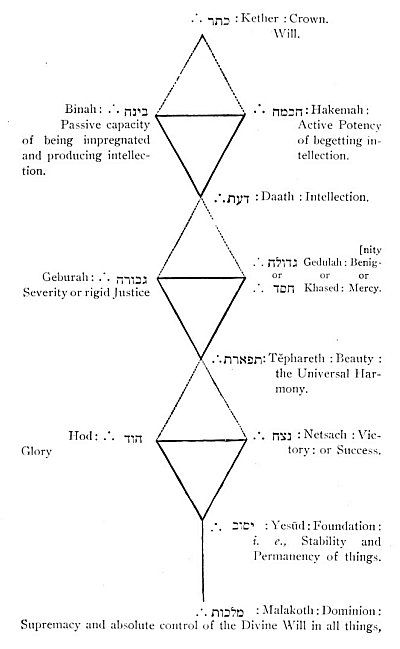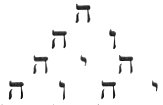So the pride of Jemsheed, one of the Persian Sun-heroes, or the solar year personified, was abruptly cut off by Zohak, the tyrant of the West. He was sawn asunder by a fish-bone, and immediately the brightness of Iran changed to gloom. Ganymede and Adonis, like Osiris, were hurried off in all their strength and beauty; the premature death of Linus, the burthen of the ancient lament of Greece, was like that of the Persian Siamek, the Bithynian Hylas, and the Egyptian Maneros, Son of Menes or the Eternal. The elegy called Maneros was sung at Egyptian banquets, and an effigy enclosed within a diminutive Sarcophagus was handed round to remind the guests of their brief tenure of existence. The beautiful Memnon, also, perished in his prime; and Enoch, whose early death was lamented at Iconium, lived 365 years, the number of
p. 590
days of the solar year; a brief space when compared with the longevity of his patriarchal kindred.
The story of Osiris is reflected in those of Orpheus and Dionusos Zagreus, and perhaps in the legends of Absyrtus and Pelias, of Æson, Thyestes, Melicertes, Itys, and Pelops. Io is the disconsolate Isis or Niobe: and Rhea mourns her dismembered Lord, Hyperion, and the death of her son Helios, drowned in the Eridanus; and if Apollo and Dionusos are immortal, they had died under other names, as Orpheus, Linus, or Hyacinthus. The sepulchre of Zeus was shown in Crete. Hippolytus was associated in divine honors with Apollo, and after he had been torn to pieces like Osiris, was restored to life by the Pæonian herbs of Diana, and kept darkling in the secret grove of Egeria. Zeus deserted Olympus to visit the Ethiopians; Apollo underwent servitude to Admetus; Theseus, Peirithous, Hercules, and other heroes, descended for a time to Hades; a dying Nature-God was exhibited in the Mysteries, the Attic women fasted, sitting on the ground, during the Thesmophoria, and the Bœotians lamented the descent of Cora-Proserpine to the Shades.
But the death of the Deity, as understood by the Orientals, was not inconsistent with His immortality. The temporary decline of the Sons of Light is but an episode in their endless continuity; and as the day and year are more convenient subdivisions of the Infinite, so the fiery deaths of Phaëthon or Hercules are but breaks in the same Phœnix process of perpetual regeneration, by which the spirit of Osiris lives forever in the succession of the Memphian Apis. Every year witnesses the revival of Adonis; and the amber tears shed by the Heliades for the premature death of their brother, are the golden shower full of prolific hope, in which Zeus descends from the brazen vault of Heaven into the bosom of the parched ground.
BAL, representative or personification of the sun, was one of the Great Gods of Syria, Assyria, and Chaldea, and his name is found upon the monuments of Nimroud, and frequently occurs in the Hebrew writings. He was the Great Nature-God of Babylonia, the Power of heat, life, and generation. His symbol was the Sun, and he was figured seated on a bull. All the accessories of his great temple at Babylon, described by Herodotus, are repeated with singular fidelity, but on a smaller scale, in the Hebrew tabernacle and temple. The golden statue alone is wanted to complete
p. 591
the resemblance. The word Bal or Baal, like the word Adon, signifies Lord and Master. He was also the Supreme Deity of the Moabites, Amonites, and Carthaginians, and of the Sabeans in general; the Gauls worshipped the Sun under the name of Belin or Belinus: and Bela is found among the Celtic Deities upon the ancient monuments.
The Northern ancestors of the Greeks maintained with hardier habits a more manly style of religious symbolism than the effeminate enthusiasts of the South, and had embodied in their Perseus, HERCULES and MITHRAS, the consummation of the qualities they esteemed and exercised.
Almost every nation will be found to have had a mythical being, whose strength or weakness, virtues or defects, more or less nearly describe the Sun’s career through the seasons. There was a Celtic, a Teutonic, a Scythian, an Etruscan, a Lydian Hercules, all whose legends became tributary to those of the Greek hero. The name of Hercules was found by Herodotus to have been long familiar in Egypt and the East, and to have originally belonged to a much higher personage than the comparatively modern hero known in Greece as the Son of Alcmena. The temple of the Hercules of Tyre was reported to have been built 2300 years before the time of Herodotus; and Hercules, whose Greek name has been sometimes supposed to be of Phœnician origin, in the sense of Circuitor, i.e. “rover” and “perambulator” of earth, as well as “Hyperion” of the sky, was the patron and model of those famous navigators who spread his altars from coast to coast through the Mediterranean, to the extremities of the West, where “ARKALEUS” built the City of Gades, and where a perpetual fire burned in his service. He was the lineal descendant of Perseus, the luminous child of darkness, conceived within a subterranean vault of brass; and he a representation of the Persian Mithras, rearing his emblematic lions above the gates of Mycenæ, and bringing the sword of Jemsheed to battle against the Gorgons of the West. Mithras is similarly described in the Zend-Avesta as the “mighty hero, the rapid runner, whose piercing eye embraces all, whose arm bears the club for the destruction of the Darood.”

Moe is the founder of GnosticWarrior.com. He is a father, husband, author, martial arts black belt, and an expert in Gnosticism, the occult, and esotericism.





